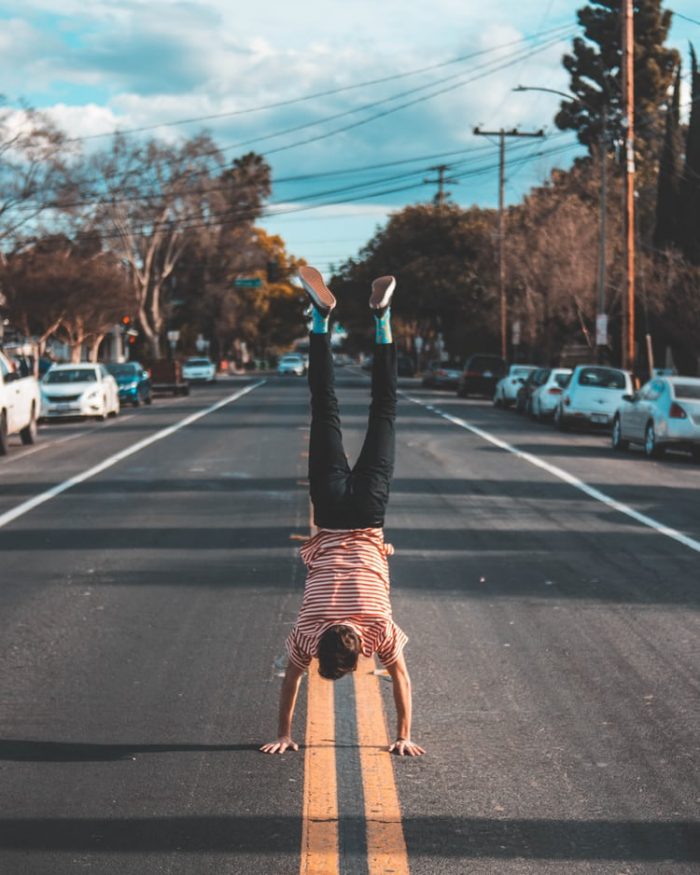Writing isn’t only a head game. It’s a bum game too—meaning that there’s a lot of sitting.
Those glutes get pretty nasty, roping in the lumbar and neck muscles, and getting the trapezius to join in the bullying of our bodies.
After sitting eight hours a day at the computer, for six weeks solid while finishing my first book I promised myself—never again.
Never again would I abuse my body to the point where I needed my osteopath’s number on speed dial and six months of rehab as if I’d been in a car accident.
I’d always treated exercise as an activity that took the place of writing—it was “either-or.” Writing would always win. I kept telling myself “when I have time, I’ll go for a swim, a walk or to the gym.” Exercise became like a friend I kept telling, “Let’s get together one of these days…” without ever committing.
The author Tom Robbins once said in an interview that to prepare for writing, writers need to spend half an hour each day doing some kind of movement, because we spend too much in our heads and need to get back in our bodies.
Amen, to that brother—it gave me the kick up the butt I needed. I decided to stop treating exercise as an alternative to writing, and invite it into my writing practice.
At the time I had no idea just how transformative that transition would become for me and my writing, especially when I took up yoga two years ago.
Here are some exquisite overlaps between yoga and writing:
Make it a practice.
Yoga isn’t a hobby. It’s not something to do when we’re bored or there’s nothing good on TV. It’s a practice—and ideally, it’s a daily practice. It becomes how we live. It’s the same with writing.
Do it without judgment.
We come to yoga to learn more about the body, without the crippling obstacle of judgment. Some days we’ll be supple and strong, others we’ll be stiff and sore. It’s all yoga. With writing, as long as we’re putting words on the page, we’re doing what we’re meant to be doing as writers. Some days we’ll write gems and some days we’ll write trash. Good days, bad days, it’s all writing.
Find the delicate balance between grace and effort.
In yoga, the skill is in listening to the body, honouring its wisdom as well as its aches. I’ve learned not to push too hard or too far, but also to challenge myself when I can feel myself slacking off. Writing is no different—to find our writing voice, we must put in the effort, but not be a try-hard. At some point, we must surrender and allow a voice to emerge.
It’s you and the mat.
I love the focus that yoga brings, where my whole world shrinks to the space on my mat and just for that time, all I have to do is be fully present. In writing, it’s just you and the page.
We learn more about who we are on the mat.
In yoga, we tune in to the body. It’s a very specialized kind of listening, the sort of listening we don’t do much of in our daily lives. When we write, we must listen in the same way to the stories of our hearts. As if with each word, we are saving ourselves a little more.
We journey from balasana (child’s pose) to shivasana (corpse pose).
We can live an entire life in an hour on the mat, and each time we return to the mat, we get to journey again. Writing is a journey of making meaning. In writing our stories, we birth a new self on the page and as we deepen into our senses, memories and emotions, owning them in words, paradoxically we’re able to let them go—so we learn to “die” and surrender the ego.
Thinking of yoga and writing in this conversation with each other curbs my inclination to duality: this or that. As Rumi says, “‘There are hundreds of ways to kneel and kiss the ground.”
Love elephant and want to go steady?
Sign up for our (curated) daily and weekly newsletters!
Apprentice Editor: Sue Adair/ Editor: Renée Picard











Read 0 comments and reply